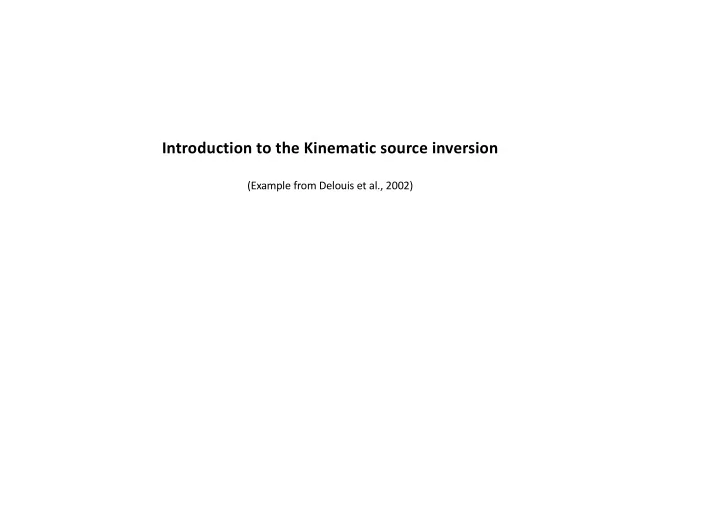

Introduction to the Kinematic source inversion (Example from Delouis et al., 2002)
Kinematic source model : point source Local Source Time Function (local STF) (moment rate) Sub-fault k M 0 = µ .S.Slip with S = sw.sl Bertrand Delouis Kinematic inversion and example for the 1999 Izmit EQ
Kinematic model Unknown per sub-fault: • t k : onset time of rupture • rake : slip angle • amplitudes of the local source time function (local STF) (the local STF can be integrated to obtain the local seismic moment, hence the local slip knowing µ and the sub-fault area) Computation of the elastic response of the Earth: Local Source • Discrete wavenumber integration method (Bouchon 1981) Time Function (local STF) for local to regional seismological data • Dislocation model (Savage 1980) for geodetic data Inversion method: Sub-fault k M 0 = µ .S.Slip with S = sw.sl • Non linear, simultated annealing 25 novembre 2009 Bertrand Delouis Kinematic inversion and example for the 1999 Izmit EQ
Izmit earthquake (Mw 7.6 1999) Red lines: surface breaks of Izmit earthquake Bertrand Delouis Kinematic inversion and example for the 1999 Izmit EQ
Kinematic model Slip distribution resulting from the joint inversion of teleseismic, strong-motion, GPS, and InSAR data Bertrand Delouis Kinematic inversion and example for the 1999 Izmit EQ
Data modeling from joint inversion Bertrand Delouis Kinematic inversion and example for the 1999 Izmit EQ
Global STF, sum of the contributions of all the local STFs shifted by their onset times Bertrand Delouis Kinematic inversion and example for the 1999 Izmit EQ
Application (exercice): the 2018 Mw 7.5 PALU (Indonesia) earthquake
Teleseismic stations (P and SH broadband waveforms) Regional seismic stations (broadband and strong-motion full waveforms) Focal mechanism used
Faut model (coords in km) hypocenter
Slip distribution at zero iteration Slip distribution at end of iterations (initial parameter values) Beware: not same color scales Dynamic model reproducing teleseismic, tsunami, InSAR and optical correlation displacements Ulrich et al., 2019
Global STF at zero iteration (initial parameter values) Global STF at end of iterations Note: the spiky overall shape ff the STF suggests elementary triangular functions are slightly too narrow
Rupture timing at zero iteration Rupture timing at end of iterations (initial parameter values) 3 km/s 2 km/s 2 km/s 3 km/s s s / / m m k k 4 4 5 km/s 5 km/s
Note 1: the single rupture plane used in this exercise is a strong simplification of reality… Note 2: convergence of the slip inversion has been made fast for the purpose of the exercise. The result is hence not fully optimized.
File « param_rupt » defining the kinematic model and some inversion parameters strength of smoothing on slip strength of smoothing on rupture velocity strength of the seismic moment minimization It would be possible to « play » with parameters in green, which do not require a re-generation of the Green’s functions Local Source Time Function (local STF) number of elementary triangular functions used for local STFs shear modulus used (dyn.cm) duration (s) of elementary triangular functions used for local STFs to convert moment in slip weight of reginal data in the inversion upper bound for rupture velocity (km/s) weight of teleseismic data in the inversion lower bound for rupture velocity (km/s)
Recommend
More recommend